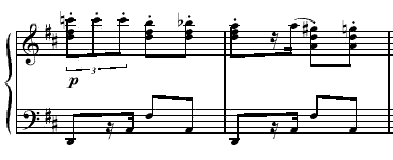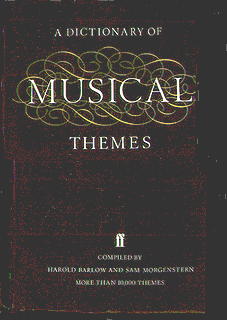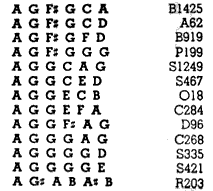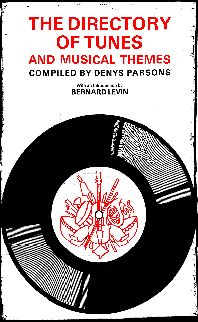The search for a notation index
An article by Niclas Fogwall: © 2001
Reprinted edition: Images and broken links are restored wherever possible. Imagine you are listening to a musical theme and you fall in love with it. You want to hear it again. Or perhaps you want to buy the record of that tune that your beloved loves to hear. But you don't know the title or the composer of this particular piece. You start asking your friends, humming the melody. To your disappointment nobody can help you. So you are stuck. Years go by and you still once in a while think about that mysterious tune you can never figure out what it is... Well... you are not alone. This problem is a very old one, which has haunted us for generations. Actually, it was one of the key questions when developing the first notation schemes over a thousand years ago. Back in those days the first priority was to accurately transcribe the music to paper signs as detailed as possible. They started using note rules and simple marks to position each note. After generations of musicians and researchers dealing with the subject, it finally resulted in the familiar music sheets of today with barlines, times, treble clef, bass clef, quarter notes, eighth notes and so on...
But how to identify a particular tune... this was an apparent lower priority. Most important in those days was to make sure that composers could put their music on paper and that musicians could perform it the way the composer wanted to, not to let "ignorant" people search for a particular piece.
A Dictionary of Musical ThemesIn 1948 Harold Barlow and Sam Morgenstern published A Dictionary of Musical Themes, containing the first note entries of more than 10,000 pieces and a newly developed notation index. In the book John Erskine wrote:I understood what Mr. Barlow and Mr. Morgenstern would try to do; since letters can easily be indexed, and musical notes cannot be, they would try to translate the notes into letters. The notation index, conceived by Barlow, is based on the key C major or C minor. Then by writing down the letters by which the notes are named, and find the resulting letter sequence in the index, we will be directed at once to the name of the original work and the name of its composer. There are between 6 and 10 letters in the index of each theme. Here is an example. Prokofiev's Classical Symphony Op. 25 (1917), the third movement, "Gavotte". Listen to it here. H A G# A A A which is transposed to A G F# G G G There is a simple transposition key table as a quick reference in the book. It is however difficult for non-trained musicians to know the exact notation key. If you don't have it in your head you have to try with each of the 15 transposition alternatives until you find it. It could be acceptable if you are only searching for one particular piece but a real headache if you have 10 pieces in your head as it could take up to 150 searches until you find them all in the index.
You are also in this case dependent on some kind of musical instrument to play the tune on so that you can write down the letters to search for.
The Directory of Tunes and musical ThemesIn 1975 Denys Parsons published The Directory of Tunes and musical Themes, which later became known as the up-down book.
Back to our example. Prokofiev's Classical Symphony Op. 25 (1917), the third movement, "Gavotte". Listen to it here.
The asterisk (*) indicates the first note.
It could be wise combining these two dictionaries if you can play a simple melody on a musical instrument. Unlike Parsons' book, Barlow's & Morgenstern's book contains the first note entries sorted by composer besides the somewhat more complex notation index. It is therefore useful as a general music dictionary. Parsons' book is more useful when searching for tunes as the index is independent of transposition and exact note details, suitable for the majority of music lovers. Barlow's & Morgenstern's A Dictionary of musical Themes and Denys Parsons' The Directory of Tunes and musical Themes are both out of print. Barlow & Morgenstern's book is available in used condition for a fair price. Parsons' book is however much more difficult to get hold of as it is since long out of print. Some book sellers list the book as new and available although they don't have it in stock, hoping in vain to supply a copy from the publishers. After many patient searches on the internet I finally got hold of a fine copy (probably unread) for $70. In 2001 there was a book dealer in the UK who sold a used copy in fine condition for only $23 but someone bought it just before me... For the moment, as I write this, the book is extremely hard to find. If you find a copy, expect a price of up to $700 for a copy in fine condition. If you are just curious to read it, check out the libraries as the book is available as a work of reference in many larger libraries worldwide. Finally, here are som sources on the internet where you may find the book: - Used Book Search, a kind of "crawler" who searches the databases (35 million books) of many U.S. and U.K. book sellers. Here I found my copy of the book. - BookFinder, another big "crawler" who searches for both new and used books. - Svenska Akvariatföreningen, searches the databases of many Scandinavian book sellers. One bookseller sold a copy earlier this year for 1000 SEK ($100). - eBay, perhaps not the best place to find the book but someone once tried to sell a copy here for an opening bid of £30 ($45). He received no bids at all. After the auction he decided to keep the book. If you know of any other search engine who covers other book sellers let me know!
LinksMelodyhoundRainer Typke and Lutz Prechelt built a recognition program as part of an intermediate thesis in their Informatics study at Karlsruhe University, Germany. They had an old photocopy of Denys Parson's book, scanned it, performed OCR, wrote a program that postprocessed the results, and cleaned up the result of that by hand. Typke is now working on this search form and you can even whistle the tune you search for with the help of a java application. He is open for suggestions on how to improve his site.
Themefinder
AI Song Recogniser
David W. Maves notation index
|




 His idea came up when he thought of Barlow's notation index and the problem for non-skilled musicians to use it effectively. Then it suddenly became clear to him that it would be much easier by using an "up-down" index, based on whether the note goes up or down or is the same as the preceding note. During the year to come he constructed his own index, based on this method, consisting of about 10,000 themes including popular tunes and national anthems. As history shows, it's not easy convincing investors when introducing new ideas. It was met by scepticism among the publishers at first but Parsons refused to give up. His persistence finally resulted in this book which nowadays sadly enough is out of print and very hard to find except as a work of reference in some libraries.
His idea came up when he thought of Barlow's notation index and the problem for non-skilled musicians to use it effectively. Then it suddenly became clear to him that it would be much easier by using an "up-down" index, based on whether the note goes up or down or is the same as the preceding note. During the year to come he constructed his own index, based on this method, consisting of about 10,000 themes including popular tunes and national anthems. As history shows, it's not easy convincing investors when introducing new ideas. It was met by scepticism among the publishers at first but Parsons refused to give up. His persistence finally resulted in this book which nowadays sadly enough is out of print and very hard to find except as a work of reference in some libraries.

